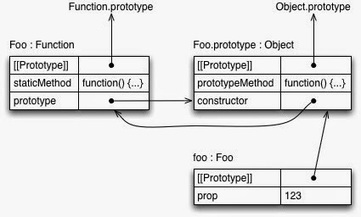Modular compact standard library for JavaScript. Includes polyfills for ECMAScript 5, ECMAScript 6: symbols, collections, iterators, promises, ECMAScript 7 proposals; setImmediate, array generics. Some additional features such as dictionaries, extended partial application, console cap, date formatting. You can require only standardized features polyfills, use features without global namespace pollution or create a custom build.
Get Started for FREE
Sign up with Facebook Sign up with X
I don't have a Facebook or a X account



 Your new post is loading... Your new post is loading...
 Your new post is loading... Your new post is loading...
Current selected tag: 'ES6'. Clear
No comment yet.
Sign up to comment
ES6 generators seem to be a very good fit for handling asynchronous actions. I've been using a library, generator-runner, which uses ES6 generators for running async tasks. To use the library you create a runner that takes two parameters:
Callback Hell, also known as Pyramid of Doom, is an anti-pattern seen in code of programmers who are not wise in the ways of asynchronous programming. So it is definitely recommended to do it right from the get-go and avoid deeply-nested callbacks. My favourite solution for this will be the usage of the Promise object. I have been dealing with Node.js for my last few projects and Promise managed to keep my sanity in check. But if you are looking for something more edgy, you will love Generators. I will touch more in depth about both approaches below. Generators are functions which can be exited and later re-entered. ES6 comes with a new feature named Generator.Generators comes with many feature to be used by JavaScript developer.
From
medium
If you write ES6 with Babel but JSHint holds you back, I have some good news! In early 2015, I switched from React’s JSX compiler to Babel in order to use ES6 (and some ES7) syntax freely. It’s a tad slower but …rest assured, it’s the future. I never regretted switching to Babel for a moment, and I only have the highest praise for its authors and contributors. My only pain was getting Babel code to lint. This sixth edition of JavaScript introduces a lot of new language features, it might even be the most feature packed revision to date in terms of language additions, and that is with some of the features scheduled, like comprehensions and rest and spread properties being delayed to the next edition. These features are also backwards compatible, in the sense that they are mostly syntatic sugar and can be de-sugared to older versions of the language, meaning we can use them right now with a compiler like babel
From
medium
In this post I am going to introduce you to some of these features used inES6 Fiddle. I recommend you to play with them and get a feeling of what’s to come. These are the features that are being covered:
Let’s get started! You can follow this post with ES6 Fiddle side by side. ECMAScript 6 introduces a new interface for iteration, Iterable. This blog post explains how it works, which language constructs consume data via it (e.g., the new for-of loop) and which sources provide data via it (e.g., arrays).
Jan Hesse's insight:
Recently, TC39 decided on the final semantics of classes in ECMAScript 6. This blog post explains how their final incarnation works. The most significant recent changes were related to how subclassing is handled. Contents:
MetaES is a metacircular interpreter written in JavaScript at EcmaScript 5.1 standard, so it can run on pretty any environment that supports ES5, for example modern browsers (both with mobile), nodejs, rhino, nashorn and other ECMAScript interpreters. The mapWith and foldWith functions we wrote in Destructuring and Recursion in ES6 are useful for illustrating the basic principles behind using recursion to work with self-similar data structures, but they are not “production-ready” implementations. One of the reasons they are not production-ready is that they consume memory proportional to the size of the array being folded. ES6 transpilers are actively being developed and are catching up to CoffeeScript in functionality. This post only covered a handful of the features that ES6 is bringing to JavaScript but you can find out more about what’s been covered and the other features here.
Cody Lindley explains why enterprise JavaScript developers still need to care about ES3 and strategies for developers who want to use ES5/ES6 features today |
A nice collection of source code snippes to show what has changed since ES5. Inspired by their prevalence in modern Javascript, the arrow provides a shorthand for declaring anonymous functions. Let's take a look.... On February 1, 2015, I held the 90 minute talk “Using ECMAScript 6 today” at the Rolling Scopes Conference in Minsk. A video recording of that talk is online: As mentioned in the introduction of the first article, ES6 is designed to fit JavaScript better for writing larger applications. To do so, the language designers added a number of new features that got inspired from typed substitutes of JavaScript and also from a number of other libraries, including some server-side libraries. Following are the new and updated objects at a glance:
Current advancements in ECMAScript are a great opportunity, but also a challenge for the web. Whilst adding new, important features we’re also running the danger of breaking backwards compatibility. JavaScript doesn’t force you to write organised code. From a syntax point of view and when it comes to type safety and memory allocation it is an utter mess. This made JavaScript the success it is now. It is a language used in client environments like browsers and apps. Two ECMAScript 6 features enable an intriguing new style of asynchronous JavaScript code: promises and generators. This blog post explains this new style and presents a way of using it without promises. Before ECMAScript 6, you couldn’t pause and resume the execution of code, but you could simulate it, by putting console.log(result) into a callback, a so-calledcontinuation. In this article Ravi Kiran describes Object.observe, a feature part of the ECMAScript 7 specifications, that allows for native two-way binding. One of the big “WTF” hurdles for apprentice JavaScript developers, that come from languages that mostly embrace synchronous and blocking IO APIs like Java or PHP is to get into thinking asynchronously about everything IO related in JavaScript with its event loop construct. It is actually one of the cool things about JavaScript and why NodeJS on the server got so much attention in the beginning, so it is something anyone at least half serious about learning JS should learn about. Iteration for functions and objects has been around for many, many decades. For simple linear collections like arrays, linked lists, stacks, and queues, functional iterators are the simplest and easiest way to implement iterators. In programs involving large collections of objects, it can be handy to implement iterators as objects, rather than functions. The mechanics of iterating can then be factored using the same tools that are used to factor the mechanics of all other objects in the system. Fortunately, an iterator object is almost as simple as an iterator function. Instead of having a function that you call to get the next element, you have an object with a.next() method. The blog post covers new features of strings in ECMAScript 6 (ES6). Contents: 1. Unicode code point escapes JavaScript has been officially initiated as an object-oriented language with the introduction of classes in ECMAScript 6. React 0.13 has just been released into beta, a release I've been eagerly anticipating! This has been the release where finally they will be supporting ES6 classes to create React components. Fully supported, no messing about and jumping through hoops and hoping that breaking API changes don't drop in and catch you off guard. |




























